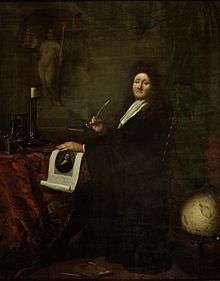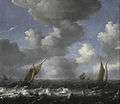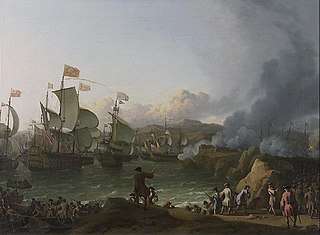Ludolf Bakhuizen
Ludolf Bakhuizen[1][2] (28 December 1630 – 7 November 1708) was a German-born Dutch painter, draughtsman, calligrapher and printmaker.[3] He was the leading Dutch painter of maritime subjects after Willem van de Velde the Elder and Younger left for England in 1672. He also painted portraits of his family and circle of friends.[3]

Life
He was born in Emden, East Frisia, and came to Amsterdam in about 1650, working as a merchant's clerk and a calligrapher.[4] He discovered so strong a genius for painting that he relinquished the business and devoted himself to art from the late 1650s, initially in pen drawings. He studied first under Allart van Everdingen and then under Hendrik Dubbels, two eminent masters of the time, and soon became celebrated for his sea-pieces, which often had rough seas.[5]
He was an ardent student of nature, and frequently exposed himself on the sea in an open boat in order to study the effects of storms. His compositions, which are numerous, are nearly all variations of one subject, the sea, and in a style peculiarly his own, marked by intense realism or faithful imitation of nature. In his later years Bakhuizen employed his skills in etching; he also painted a few examples each of several other genres of painting, such as portraits, landscapes and genre paintings.[5]
During his life Bakhuizen was visited by Cosimo III de' Medici, Peter the Great and also worked for various German princes. In 1699 he opened a gallery on the top floor of the famous Amsterdam townhall. After a visit to England he died in Amsterdam on 17 November 1708.[5]
Bakhuizen painted portraits of his large circle of friends. These are of lesser artistic value but provide an insight into his good relations with contemporary scholars and literary figures.[3]
Gallery
 Ships in a Storm, 1670s - 1690s
Ships in a Storm, 1670s - 1690s Seascape and Fishing Boats, 1708
Seascape and Fishing Boats, 1708 Battle of Vigo Bay 1702
Battle of Vigo Bay 1702 Dutchman Embarking onto a Yacht, 1670-1679
Dutchman Embarking onto a Yacht, 1670-1679._Vice-admiraal_Rijksmuseum_SK-A-832.jpeg) Johan de Liefde, Vice-Admiral
Johan de Liefde, Vice-Admiral The Y at Amsterdam viewed from Mussel Pier
The Y at Amsterdam viewed from Mussel Pier
Notes
- Name also spelled Ludolf Backhuijzen, Ludolf Backhuizen, Ludolph Backhuyzen, Ludolph Backhuysen, Ludolf Bakhuysen
- Ludolf Bakhuizen at the Netherlands Institute for Art History (in Dutch)
- Broos 2017
- Houbraken 1718.
- Chisholm 1911, p. 135.
References
- Broos, B. P. J. (6 January 2017), "Bakhuizen, Ludolf", Grove Art Online, Oxford Art Online, Oxford University Press
- Houbraken, Arnold (1718), "Ludolf Bakhuizen biography", De groote schouburgh der Nederlantsche konstschilders en schilderessen, Digital library for Dutch literature
- MacLaren, Neil (1991), The Dutch School, 1600–1800, Vol. I, National Gallery Catalogues, London: National Gallery, ISBN 0-947645-99-3
Attribution:

External links
- 61 paintings by or after Ludolf Bakhuizen at the Art UK site


- "Ships in Distress in a Heavy Storm", Rijksmuseum